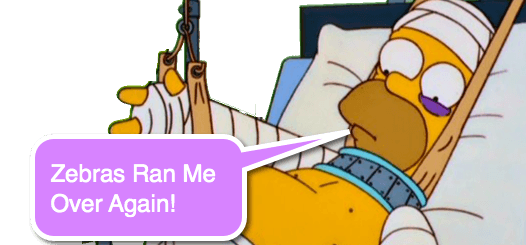Pheochromocytoma
The PedEM Morsels often focus on remaining vigilant. That certainly does not mean ordering a million unnecessary tests, but rather strives to augment our awareness of the complex systems we evaluate and appreciate that certainty is a fool’s proclamation. While we easily consider the common emergencies, let us not forget that there are devastating “Zebras” that are just as able to trample us and our patients. We have discussed several before (ex, Osterosarcoma, Grandenigo’s Syndrome) and we have also covered an uncommonly encountered finding of Hypertensive Emergency. These two concepts bring to mind another zebra: Pheochromocytoma.
Pheochromocytoma Basics
- Arise from neural crest cell derived organs, known as paraganglia.
- “Pheochromocytoma” is term used for catecholamine-secreting tumors that occur in adrenal medulla.
- “Paraganlioma” is term for extra-adrenal tumors and can be derived from sympathetic or parasympathetic paraganglia.
- Best to not interchange the two terms as they have different genetics, presentations, and malignant potential. [Waguespack, 2010]
- Rare Neuroendocrine tumors
- Comprise < 7% of sympathetic nervous system tumors.
- ~10-20% are diagnosed during childhood.
- Average age of childhood diagnosis = 11 years
- Synthesize and secrete catecholamines
- Dopamine, Norepinephrine, and Epinephrine
- Synthesize and secrete catecholamine metabolites
- Homovanillic acid, Normetanephrine, and Metanephrine
Pheochromocytoma and Genes
- May occur sporadically, although often are found to have identified genetic mutations
- May occur in association with hereditary syndrome
- von Hipple-Lindau disease
- Multiple Endocrine Neoplasia (MEN) 2A and 2B
- Familial Paraganglioma Syndromes
- Neurofibromatosis type 1
- Tuberous Sclerosis complex
- Rarely cause malignancy [Allan, 2013]
Pheochromocytoma Presentations
- Mass effects of tumor
- Ex: pain from compression of adjacent structures
- Less common in children
- Functional tumors secrete catecholamines
- Presentation related to various catecholamines
- Patient’s sensitivity to catecholamines also plays role.
- Symptoms: [Waguespack, 2010]
- Headache, Palpitations, Diaphoresis = “Classic” triad
- Hypertension
- Often sustained, rather than episodic
- Can cause Hypertensive Crisis
- Syncope
- Pallor
- Anxiety!
- End Organ Injury
- Cardiomyopathy
- CVA
- Pancreatitis
- Death (the ultimate end organ damage)
- Symptoms from ectopic hormone production
- Gigantism
- Cushing syndrome
- SIADH
- Hypercalcemia
- Secretory Diarrhea (vasoactive intestinal peptide)
Pheochromocytoma Diagnosis
- First, we have to think of it!
- Is this presentation “simple anxiety” or is it consistent with episodic catecholamine surges?
- Diagnostic tests of choice for secretory tumors
- Urine metanephrines and normetanephrines
- Plasma metanephrines and normetanephrines
- Sample needs to be obtained after the “terror” of placing the IV has passed.
- Recommended to be obtained with patient in supine position 3o minutes after IV placement.
- Age appropriate reference ranges should be used. [Weise, 2002]
- Sample needs to be obtained after the “terror” of placing the IV has passed.
Pheochromocytoma Initial Therapies
- No universally accepted management plan, particularly for kids. [Waguespack, 2010]
- Alpha Blockade
- Improves symptoms and lowers BP.
- Cause reflex tachycardia
- Examples:
- Phentolamine – short acting
- Phenoxybenzamine – long acting (often used in while awaiting surgery)
- Prazosin
- Doxazosin
- Calcium Channel blockers
- Nicardipine
- Beta-Blockade
- START ALPHA BLOCKERS BEFORE BETA BLOCKERS.
- Beta-blockers can help control reflex tachycardia seen after alpha-blockers.
- Use before alpha-blockers can lead to unopposed alpha effects and worsening hypertension
- Ultimately, resection of the tumors are required, which can be tricky as hypotension often results after removal of the catecholamine source. [Kalra, 2012]
References
Bausch B1, Wellner U, Bausch D, Schiavi F, Barontini M, Sanso G, Walz MK, Peczkowska M, Weryha G, Dall’igna P, Cecchetto G, Bisogno G, Moeller LC, Bockenhauer D, Patocs A, Rácz K, Zabolotnyi D, Yaremchuk S, Dzivite-Krisane I, Castinetti F, Taieb D, Malinoc A, von Dobschuetz E, Roessler J, Schmid KW, Opocher G, Eng C, Neumann HP. Long-term prognosis of patients with pediatric pheochromocytoma. Endocr Relat Cancer. 2013 Dec 16;21(1):17-25. PMID: 24169644. [PubMed] [Read by QxMD]
Allan B1, Davis J, Perez E, Lew J, Sola J. Malignant neuroendocrine tumors: incidence and outcomes in pediatric patients. Eur J Pediatr Surg. 2013 Oct;23(5):394-9. PMID: 23444065. [PubMed] [Read by QxMD]
Kalra Y1, Agarwal HS, Smith AH. Perioperative management of pheochromocytoma and catecholamine-induced dilated cardiomyopathy in a pediatric patient. Pediatr Cardiol. 2013;34(8):2013-6. PMID: 23132179. [PubMed] [Read by QxMD]
Sarathi V1, Pandit R, Patil VK, Lia AR, Bandgar TR, Shah NS. Performance of plasma fractionated free metanephrines by enzyme immunoassay in the diagnosis of pheochromocytoma and paraganglioma in children. Endocr Pract. 2012 Sep-Oct;18(5):694-9. PMID: 22982790. [PubMed] [Read by QxMD]
Waguespack SG1, Rich T, Grubbs E, Ying AK, Perrier ND, Ayala-Ramirez M, Jimenez C. A current review of the etiology, diagnosis, and treatment of pediatric pheochromocytoma and paraganglioma. J Clin Endocrinol Metab. 2010 May;95(5):2023-37. PMID: 20215394. [PubMed] [Read by QxMD]
Weise M1, Merke DP, Pacak K, Walther MM, Eisenhofer G. Utility of plasma free metanephrines for detecting childhood pheochromocytoma. J Clin Endocrinol Metab. 2002 May;87(5):1955-60. PMID: 11994324. [PubMed] [Read by QxMD]



[…] Pheochromocytoma […]
[…] it is useful to know that they do exist. We have previously covered a few “zebras” (ex, Pheochromocytoma, Gradenigo’s Syndrome, Osteosarcoma, Hypertensive Emergency, Cerebral Venous Thrombosis) and […]
Thanks for sharing the post which explains the Pheochromocytoma in detail.Keep posting more.
http://www.kneereplacementsinindia.com